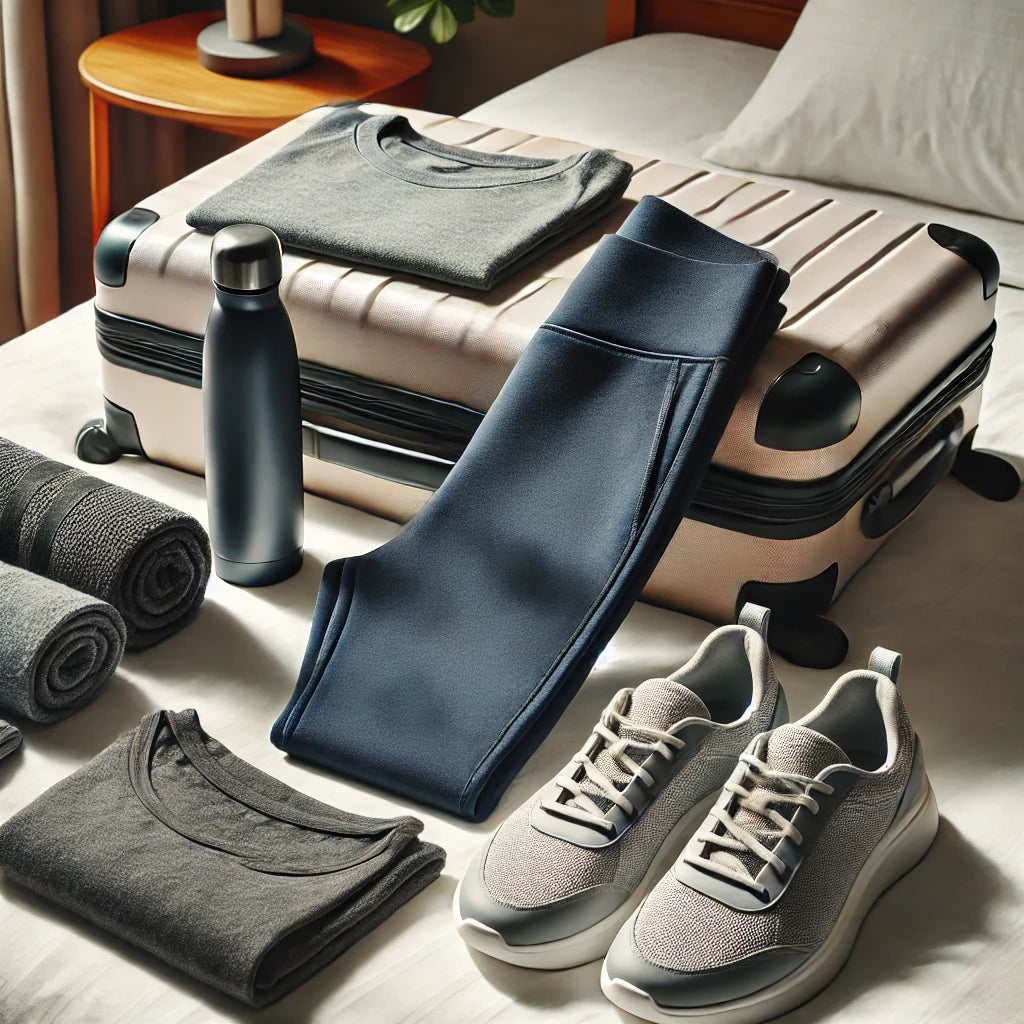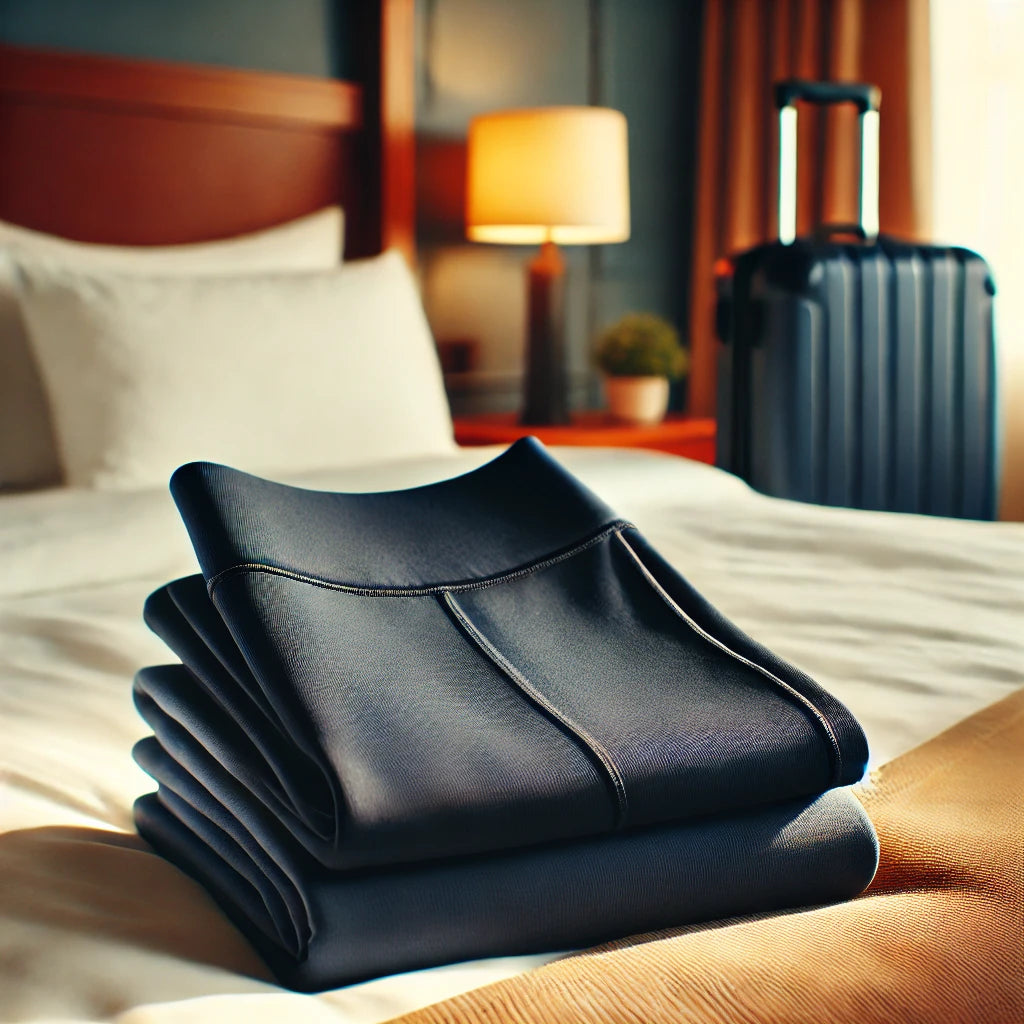For the avid traveler who values staying fit on the go, a high-quality fitness mat is an essential companion. Whether you’re stretching out after a long flight, doing yoga in a hotel room, or powering through a bodyweight workout in a park, your fitness mat provides the foundation for maintaining your routine. However, frequent travel can take a toll on your gear. From the rigors of packing and unpacking to exposure to different surfaces and climates, your fitness mat needs proper care to remain effective and durable. In this guide, we’ll explore how to maintain your fitness mat during frequent travels, ensuring it stays clean, functional, and ready for your next workout. We’ll cover essential cleaning techniques, tips for storage and transportation, and strategies to extend the life of your mat, helping you keep your fitness journey on track no matter where your adventures take you.

Choosing the Right Fitness Mat for Travel
A. Types of Fitness Mats
Understanding the different types of fitness mats is crucial for selecting one that suits your travel needs:
- Yoga Mats: These are typically thinner and provide a sticky surface to help maintain balance during poses. Ideal for travelers practicing yoga and light exercises.
- Exercise Mats: These are thicker and offer more cushioning, making them suitable for a variety of workouts, including Pilates and bodyweight exercises.
- Travel Mats: Specifically designed for portability, these mats are usually thinner and lighter, easy to roll or fold, and often come with a carrying case.
B. Key Features to Look For
When choosing a fitness mat for frequent travel, consider the following features:
- Portability: Opt for mats that are lightweight and compact. Travel-specific mats are usually designed to be easily rolled or folded without taking up much space in your luggage.
- Durability: Look for mats made from robust materials that can withstand frequent use and different surfaces. PVC, TPE, and natural rubber are popular choices for their durability and resilience.
- Non-Slip Surface: A good grip is essential to prevent slipping during workouts. Ensure the mat has a non-slip surface on both sides.
- Thickness and Comfort: Balance between cushioning and portability. Thicker mats provide more comfort but are bulkier, while thinner mats are easier to carry but may offer less cushioning.
- Easy to Clean: Choose mats that are resistant to moisture and easy to clean, as they will be exposed to different environments.
C. Top Picks for Travel Fitness Mats
Several brands offer high-quality fitness mats that cater to travelers. Here are some top picks:
- Manduka PRO Travel Yoga Mat: Known for its durability and grip, this mat is lightweight and foldable, making it perfect for travel.
- Liforme Yoga Mat: This mat combines a sticky surface with excellent cushioning, ideal for both yoga and fitness routines.
- Jade Yoga Voyager Mat: Made from natural rubber, this mat is eco-friendly and provides great grip. It’s thin and lightweight, perfect for packing.
- Gaiam Foldable Yoga Mat: Designed to fit in a suitcase or backpack, this mat folds down to a compact size and offers a non-slip surface.
Packing Your Fitness Mat for Travel
A. Rolling vs. Folding
Deciding whether to roll or fold your fitness mat depends on its design and your packing preferences:
- Rolling: Rolling is the traditional way to pack a mat and is suitable for mats that are not designed to fold. Roll the mat tightly to save space and use a strap or carrying case to secure it.
- Folding: Many travel-specific mats are designed to be folded. This method saves space and allows the mat to fit into smaller bags. Fold the mat in half, then continue folding until it reaches a manageable size.
B. Using a Carrying Case
Investing in a good carrying case can protect your mat and make it easier to transport:
- Mat Bags: These bags are designed to hold rolled mats. Look for bags with adjustable straps and extra pockets for convenience.
- Mat Slings: Slings are minimal and lightweight, ideal for securing rolled mats while leaving them partially exposed. They are great for quick and easy access.
- Foldable Mat Cases: For mats that fold, choose a case that matches the folded dimensions. These cases often come with handles or straps for easy carrying.
C. Tips for Efficient Packing
Maximize your packing efficiency with these tips:
- Use Packing Cubes: Separate your fitness gear from other items using packing cubes. This keeps your luggage organized and protects your mat from potential damage.
- Pack in Layers: Place your fitness mat on top or at the bottom of your suitcase to maintain a flat and stable position. This prevents it from being crushed by other items.
- Utilize Luggage Space: Fold or roll your mat in a way that complements the shape of your luggage. Utilize empty spaces like the sides or corners of your suitcase.

Cleaning and Sanitizing Your Fitness Mat
A. Importance of Regular Cleaning
Maintaining cleanliness is vital for the longevity and hygiene of your fitness mat:
- Hygiene: Mats can accumulate sweat, dirt, and bacteria from different surfaces. Regular cleaning prevents odors and keeps your mat safe for use.
- Durability: Proper cleaning techniques help maintain the mat’s material and prevent wear and tear, extending its life.
B. Cleaning Methods
Choose a cleaning method based on the type of mat and the level of dirt or sweat:
- Daily Wipe-Down: After each use, wipe your mat with a damp cloth and a mild detergent or mat cleaner. This removes sweat and prevents buildup.
- Deep Cleaning: For a thorough clean, mix water with mild soap or use a dedicated mat cleaner. Scrub gently with a soft cloth or sponge, rinse with clean water, and air dry.
- Disinfecting: Use a solution of water and white vinegar or a gentle disinfectant spray to kill bacteria. Ensure the solution is safe for your mat’s material to avoid damage.
C. Drying and Storing Your Mat
Proper drying and storage techniques are essential to prevent mold and damage:
- Air Drying: After cleaning, lay your mat flat or hang it up to dry completely before rolling or folding. Avoid direct sunlight, which can degrade the material.
- Avoiding Moisture: Never store your mat when it’s damp, as this can lead to mold growth and unpleasant odors. Ensure it is completely dry before packing.
- Proper Storage: Store your mat in a cool, dry place away from direct sunlight. Use a mat bag or case to protect it from dust and damage during travel.
Protecting Your Fitness Mat from Wear and Tear
A. Choosing the Right Surfaces
Using your mat on appropriate surfaces can prevent damage and enhance its lifespan:
- Indoor Use: Use your mat on clean, smooth surfaces like hotel room floors or gym studio floors. Avoid rough or abrasive surfaces that can cause tears.
- Outdoor Use: When using your mat outdoors, place it on grass, sand, or a clean, flat surface. Avoid gravel, rocks, or uneven ground that can puncture or wear down the mat.
- Protective Layer: Consider using a towel or a mat topper to provide an extra layer of protection, especially in rough or dirty environments.
B. Avoiding Overuse
Give your mat a break to prevent excessive wear:
- Alternate Use: If possible, use different mats for different activities. For example, keep a separate mat for travel and one for home use.
- Rest Days: Allow your mat to rest and recover by alternating days of use. This helps maintain its shape and prevents early wear.
C. Inspecting Your Mat
Regularly inspect your mat for signs of wear and tear:
- Visual Check: Look for signs of cracks, tears, or thinning areas. Addressing these issues early can prevent further damage.
- Touch Test: Feel the surface for any rough or uneven spots that could indicate wear. Check the mat’s grip and cushioning for any changes.

Extending the Life of Your Fitness Mat
A. Using Mat Accessories
Accessories can enhance your mat’s durability and functionality:
- Mat Towel: Place a mat towel on top of your fitness mat during workouts to absorb sweat and protect the surface.
- Grip Spray: Use a grip-enhancing spray or powder to improve traction and reduce the need for frequent cleaning.
- Corner Clips: Use corner clips to keep your mat securely in place during workouts, preventing sliding and bunching.
B. Proper Handling and Care
Treat your mat with care to extend its life:
- Gentle Handling: Avoid aggressive movements or folding that could damage the mat. Handle it gently, especially when packing and unpacking.
- Avoiding Sharp Objects: Keep your mat away from sharp objects and surfaces that can cause punctures or tears.
- Temperature Control: Store your mat in a cool environment to prevent damage from heat. Avoid leaving it in hot cars or direct sunlight.
C. Regular Maintenance
Routine maintenance keeps your mat in optimal condition:
- Periodic Deep Cleaning: Perform a deep clean every few weeks, depending on usage. This helps remove deep-seated dirt and bacteria.
- Inspect and Repair: Regularly inspect your mat and repair any minor damage immediately. Use mat repair kits or patches for small tears or holes.
Finding Replacement Mats and Gear
A. Knowing When to Replace Your Mat
Recognize the signs that indicate it’s time to replace your fitness mat:
- Significant Wear and Tear: Large cracks, tears, or worn-out areas that affect the mat’s performance and comfort.
- Loss of Cushioning: When the mat no longer provides adequate cushioning or support during workouts.
- Persistent Odors: If the mat retains odors despite regular cleaning, it may be time for a new one.
B. Shopping for Replacement Mats
When it’s time to replace your mat, consider these factors:
- Research and Reviews: Read reviews and do your research to find a high-quality mat that meets your needs. Check ratings and feedback from other travelers and fitness enthusiasts.
- Visit Fitness Stores: Explore fitness stores in your area or online to find a wide range of options. Stores often have knowledgeable staff who can help you choose the right mat.
- Consider Your Needs: Assess your fitness routine and travel habits to choose a mat that aligns with your requirements for portability, durability, and comfort.
C. Finding the Best Fitness Store
Discovering the best fitness store for your needs involves:
- Local vs. Online: Decide whether you prefer shopping at local fitness stores or online retailers. Each option has its benefits in terms of convenience and selection.
- Specialized Stores: Look for stores that specialize in fitness apparel and equipment. These stores often offer a curated selection of high-quality mats and accessories.
- Customer Service: Choose stores known for excellent customer service, as they can provide valuable advice and support during your purchase.
D. Additional Travel-Friendly Gear
Beyond your fitness mat, consider investing in other travel-friendly fitness gear:
- Compact Resistance Bands: These are lightweight and versatile, perfect for strength training on the go.
- Portable Dumbbells: Adjustable or collapsible dumbbells provide a compact solution for weight training.
- Travel Yoga Blocks: Lightweight and easy to pack, yoga blocks enhance your practice and provide support.

Incorporating Your Fitness Mat into a Travel Workout Routine
A. Designing a Travel-Friendly Workout
Create a workout routine that suits your travel schedule and space constraints:
- Bodyweight Exercises: Focus on exercises that require minimal equipment, such as push-ups, squats, and planks. Your fitness mat provides a stable surface for these movements.
- Yoga and Stretching: Incorporate yoga and stretching sessions into your routine to maintain flexibility and reduce travel-related stiffness.
- High-Intensity Interval Training (HIIT): HIIT workouts are effective for maximizing fitness in a short time. Use your mat for exercises like burpees, mountain climbers, and lunges.
B. Using Apps and Online Resources
Leverage technology to enhance your travel workouts:
- Fitness Apps: Download apps that offer guided workouts and routines. Many apps have options specifically for travel and limited space.
- Online Classes: Join virtual fitness classes or follow online videos for guided workouts. This provides structure and motivation, even when you’re away from home.
- Personalized Plans: Consider using online personal training services to get customized workout plans tailored to your fitness goals and travel schedule.
C. Staying Motivated on the Road
Maintaining motivation can be challenging when traveling. Here are some tips to keep you on track:
- Set Goals: Establish clear fitness goals for your trip. Whether it’s maintaining your routine or trying new activities, having goals keeps you focused.
- Routine and Flexibility: Establish a workout routine that fits your travel schedule but remain flexible to adapt to changes.
- Track Progress: Use a fitness tracker or app to monitor your progress and stay motivated. Seeing your achievements can be a great incentive to keep going.
Advanced Cleaning Techniques for Your Fitness Mat
A. Natural Cleaning Solutions
Using natural cleaning solutions is a safe and effective way to maintain the cleanliness and longevity of your fitness mat. These solutions are gentle on the mat's material while effectively removing dirt, sweat, and bacteria.
DIY Natural Cleaners
- Vinegar and Water Solution: Mix equal parts of water and white vinegar in a spray bottle. Vinegar is a natural disinfectant that can kill bacteria and neutralize odors without harsh chemicals.
- Essential Oil Spray: Add a few drops of essential oils like tea tree, lavender, or eucalyptus to a spray bottle filled with water. These oils have antibacterial and antifungal properties and leave a pleasant scent.
- Baking Soda Paste: For tough stains or odors, make a paste using baking soda and water. Apply the paste to the stained area, let it sit for a few minutes, then scrub gently and rinse off.
Using Natural Cleaners
- Spray and Wipe: After your workout, spray the natural cleaner on your mat and wipe it down with a soft cloth. This helps remove sweat and bacteria, keeping your mat fresh.
- Deep Cleaning: For a thorough clean, apply the cleaner liberally, scrub with a soft brush, and rinse with water. Ensure the mat is completely dry before using it again.
B. Commercial Mat Cleaners
Commercial mat cleaners are specially formulated to clean and disinfect fitness mats without damaging the material. Here’s how to choose and use them:
Selecting a Commercial Cleaner
- Mat-Safe Formulas: Choose cleaners that are specifically designed for fitness mats and are safe for the type of material your mat is made of.
- Non-Toxic and Eco-Friendly: Opt for cleaners that are free from harsh chemicals and are environmentally friendly. Brands like Manduka’s Mat Wash or Gaiam’s Clean Mat Spray are good options.
- Disinfectant Properties: Ensure the cleaner has disinfectant properties to kill germs and bacteria effectively.
Using Commercial Cleaners
- Spray and Wipe Method: Spray the cleaner onto the mat and wipe it down with a microfiber cloth. This method is ideal for daily cleaning.
- Deep Cleaning: For deeper cleaning, apply the cleaner, scrub gently with a soft brush, and rinse thoroughly with water. Allow the mat to air dry completely.
C. Cleaning in Different Environments
Your cleaning approach might vary depending on where you are using your mat. Here’s how to adapt your cleaning routine to different environments:
Hotel Rooms
- Daily Maintenance: Wipe down your mat with a cleaner after each use to remove sweat and dirt, especially if you’re using it on carpet or tiled floors.
- Quick Freshening: Use disinfectant wipes to quickly freshen up your mat if you’re in a hurry or lack access to water.
Outdoor Settings
- Pre-Cleaning: Before using your mat outdoors, wipe it down to remove any dust or particles from previous use.
- Post-Use Cleaning: After outdoor use, shake off dirt and debris, and clean the mat thoroughly to remove any surface contaminants.
Shared Spaces
- Enhanced Disinfection: In shared spaces like gyms or yoga studios, it’s crucial to disinfect your mat before and after use. Use a stronger disinfectant to ensure thorough cleaning.
- Avoid Direct Contact: Place a towel on top of the mat to minimize direct contact and reduce the need for frequent deep cleaning.

Expert Tips for Extending the Life of Your Fitness Mat
A. Preventing Damage from Sunlight and Heat
Exposure to sunlight and heat can degrade the materials of your fitness mat. Here’s how to protect your mat:
Sunlight Exposure
- Avoid Direct Sunlight: When drying your mat, avoid placing it in direct sunlight. UV rays can break down the mat's material, causing it to become brittle and fade.
- Shade and Indoor Drying: Dry your mat in a shaded area or indoors. If you must dry it outside, ensure it’s in a well-ventilated but shaded spot.
Heat Exposure
- Storage Temperature: Store your mat in a cool, dry place away from heat sources like radiators or heaters. High temperatures can cause the material to warp or deteriorate.
- Avoid Hot Environments: Don’t leave your mat in hot cars or direct sunlight for extended periods. Excessive heat can damage the mat's structure and surface.
B. Using Protective Covers and Mat Bags
Protective covers and mat bags are essential for preventing wear and tear during travel. They shield your mat from dirt, moisture, and physical damage.
Protective Covers
- Mat Towels: Use a mat towel during workouts to absorb sweat and reduce direct contact with the mat. This keeps the mat cleaner and reduces the frequency of deep cleanings.
- Mat Wraps: Consider using a mat wrap that covers the entire mat during storage. Wraps provide an additional layer of protection against dirt and abrasion.
Mat Bags
- Padded Bags: Choose padded mat bags to protect your mat from impact and rough handling. Bags with padding are especially useful for air travel.
- Ventilated Bags: Look for bags with ventilation features to allow air circulation, preventing moisture buildup and mold growth.
- Extra Compartments: Bags with extra compartments are useful for storing fitness accessories like towels, water bottles, and resistance bands.
C. Managing Wear and Tear
Regular use can lead to wear and tear on your fitness mat. Here’s how to manage and minimize damage:
Inspecting for Damage
- Routine Checks: Regularly inspect your mat for signs of wear such as cracks, tears, or thinning areas. Early detection allows for timely repairs.
- Surface Feel: Check for changes in the texture or grip of the mat. A smooth or slippery surface might indicate wear that needs attention.
Repairing Minor Damage
- Patch Kits: Use patch kits designed for fitness mats to repair small tears or punctures. Follow the kit instructions to ensure a secure and lasting repair.
- Reinforcement: Apply clear adhesive strips to reinforce areas that show signs of minor wear. This can prevent further damage and extend the mat’s usability.
D. Proper Storage Techniques
Proper storage is crucial to maintaining the shape and functionality of your mat. Here’s how to store your mat correctly:
Rolling vs. Folding
- Rolling: Roll your mat with the top side out to prevent the edges from curling up during use. Use a strap or band to secure it.
- Folding: For mats designed to be folded, fold them along the creases to avoid creating new folds that could damage the material.
Storage Location
- Dry, Cool Areas: Store your mat in a dry, cool area away from direct sunlight and moisture. Avoid places with extreme temperature fluctuations.
- Vertical Storage: If possible, store your mat vertically. This reduces pressure on any one area and helps maintain its shape.
Leveraging Additional Travel-Friendly Fitness Accessories
A. Compact and Versatile Gear
In addition to your fitness mat, consider incorporating other compact and versatile fitness accessories into your travel routine. These items enhance your workouts without adding significant bulk to your luggage.
Resistance Bands
- Types of Bands: Resistance bands come in various forms, including loop bands, tube bands with handles, and flat bands. Each type offers unique benefits for different exercises.
- Portability: Bands are lightweight and take up minimal space, making them perfect for travel. They provide a wide range of resistance levels for strength training and flexibility exercises.
Portable Weights
- Adjustable Dumbbells: These weights allow you to change the weight quickly, providing a full set of dumbbells in one compact piece of equipment. Look for travel-friendly designs that are easy to pack.
- Water-Fillable Weights: These weights can be filled with water for use and emptied for transport, offering a versatile and space-saving option for weight training.
B. Fitness Apparel for Travel
Wearing the right fitness apparel is essential for comfort and performance during your workouts. Here’s what to look for in travel-friendly fitness clothing:
Moisture-Wicking Fabrics
- Breathability: Choose apparel made from moisture-wicking fabrics like polyester or spandex that keep you dry by drawing sweat away from your skin.
- Quick-Drying: Opt for quick-drying materials that can be washed and dried quickly, making them ideal for frequent use and travel.
Versatile Designs
- Multi-Use Clothing: Look for clothing that transitions easily from workout to casual wear. Pieces like Athleta’s versatile leggings and tops are designed for both exercise and everyday activities.
- Comfort and Fit: Ensure your fitness apparel is comfortable and allows for a full range of motion. Proper fit and stretchability are key for maintaining comfort during various activities.
C. Hydration and Nutrition on the Go
Staying hydrated and nourished is crucial for maintaining your energy and performance during travel. Here’s how to manage hydration and nutrition effectively:
Reusable Water Bottles
- Insulated Bottles: Use insulated water bottles to keep your drinks cold or hot for extended periods. Brands like Hydro Flask and Yeti offer durable and travel-friendly options.
- Compact Design: Choose bottles with a compact and leak-proof design that are easy to carry in your travel bag.
Portable Nutrition
- Protein Shakers: Carry a portable protein shaker for mixing protein shakes and supplements on the go. Look for leak-proof and easy-to-clean designs.
- Healthy Snacks: Pack healthy snacks like protein bars, nuts, and dried fruits to keep your energy levels up during travel. Opt for options that are non-perishable and easy to carry.
D. Tracking and Monitoring Fitness Progress
Using technology to track and monitor your fitness progress helps you stay motivated and on track, even while traveling.
Fitness Trackers
- Wearable Devices: Devices like Fitbit, Garmin, and Apple Watch provide comprehensive tracking of your workouts, steps, heart rate, and more. They offer valuable insights into your fitness journey.
- Goal Setting: Use the tracking features to set and monitor fitness goals, such as daily step counts, calorie burns, or active minutes.
Fitness Apps
- Workout Plans: Download apps that offer tailored workout plans and routines. Apps like MyFitnessPal, Nike Training Club, and Freeletics provide a range of options for different fitness levels and goals.
- Progress Monitoring: Use app features to log your workouts, track progress, and analyze performance over time. This helps you stay focused and motivated.

Conclusion
By following these detailed guidelines, you can ensure your fitness mat and other gear remain in excellent condition, providing reliable support for your workouts no matter where your travels take you. Maintaining your fitness routine while on the go is essential for staying healthy and active, and with the right equipment and practices, you can achieve your fitness goals even during the busiest travel schedules.
Read More
- Compact Fitness Mats: Perfect for Small Spaces and Hotel Rooms
- How to Choose the Best Fitness Mat for Your Hotel Workouts
- Top 10 Fitness Mats for Effective Home Workouts
- The Benefits of Investing in a High-Quality Fitness Mat for Your Exercise Routine
- How to Choose the Perfect Fitness Mat for Your Home Workouts
- Eco-Friendly Fitness Mats: Sustainable Choices for Conscious Exercisers





